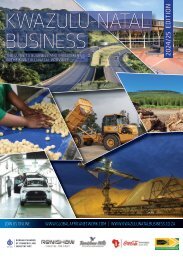Eastern Cape Business 2017 edition
The 2017 edition of Eastern Cape Business is the 10th issue of this highly successful publication that, since its launch in 2006, has established itself as the premier business and investment guide to the Eastern Cape Province. The Eastern Cape enjoys an abundance of natural and human resources, as well as established industrial infrastructure that drives the economy of the province. This includes three ports and two industrial development zones which are home to a wide range of manufacturers and exporters. The 2017 edition includes an in-depth look at the province’s two Industrial Development Zones, a focus on skills development and investment climate information from the Nelson Mandela Business Chamber and the Border-Kei Chamber of Business.
The 2017 edition of Eastern Cape Business is the 10th issue of this highly successful publication that, since its launch in 2006, has established itself as the premier business and investment guide to the Eastern Cape Province. The Eastern Cape enjoys an abundance of natural and human resources, as well as established industrial infrastructure that drives the economy of the province. This includes three ports and two industrial development zones which are home to a wide range of manufacturers and exporters.
The 2017 edition includes an in-depth look at the province’s two Industrial Development Zones, a focus on skills development and investment climate information from the Nelson Mandela Business Chamber and the Border-Kei Chamber of Business.
You also want an ePaper? Increase the reach of your titles
YUMPU automatically turns print PDFs into web optimized ePapers that Google loves.
The maritime economy is<br />
building momentum<br />
Port Elizabeth hosted the “Investing in Blue Economy” conference in 2016.<br />
The <strong>Eastern</strong> <strong>Cape</strong> is perfectly positioned to take<br />
advantage of the new interest in developing a<br />
maritime economy. The province has 800km<br />
of coastline, three ports, two industrial development<br />
zones geared to attracting investments in<br />
new sectors and an academic community geared to<br />
maritime research.<br />
A national plan called the Oceans Economy has recently<br />
been launched and the ports of East London,<br />
Port Elizabeth and Ngqura naturally feature prominently<br />
in these strategies for exploiting the coastline<br />
and the opportunities offered by busy shipping lines<br />
along the eastern seaboard.<br />
The first manifestation of national commitment to<br />
the strategy came late in 2016 with the allocation by<br />
the Department of Energy of two Liquefied Natural<br />
Gas (LNG) plants. One option for private investors<br />
to build and operate such a plant is at the Port of<br />
Richards Bay in KwaZulu-Natal. The other option (to<br />
which 1 000MW has been allocated) is the Port of<br />
Ngqura, at the Coega Industrial Development Zone<br />
(CIDZ). This signifies that port IDZs are a key plank<br />
in national energy policy, and that ties in with the<br />
Oceans Economy plan.<br />
Both IDZs have aquaculture sections and are keen<br />
to attract investors in this sector. The East London IDZ<br />
already has investors such as Pure Ocean Aquaculture<br />
and Ocean Wise. Zone 10 has been set aside within<br />
the Coega IDZ for marine farming. Fish such as Dusky<br />
Kob and abalone and seaweed are all attractive<br />
options for enterprises.<br />
The Oceans Economy forms part of the broader<br />
Operation Phakisa, a plan that targets sectors that can<br />
best achieve quick returns in terms of growth and<br />
job creation. Phakisa falls under the Department of<br />
Planning, Monitoring and Evaluation. The four target<br />
areas within the maritime strategy are: aquaculture;<br />
offshore oil and gas; marine protection and governance;<br />
marine transport and manufacturing.<br />
The untapped potential that passes South Africa’s<br />
coast is immense. This includes the fact that South<br />
Africa does maintenance on only 5% of the 13 000<br />
vessels that use SA ports and services 4-5% of the<br />
approximately 130 rigs that pass along the coast<br />
each year.<br />
Oil and gas appear to hold the most potential,<br />
and the gas plant plans for Coega and the prospect<br />
of a manganese smelting facility being established in<br />
the same IDZ suggest that this kind of energy-hungry<br />
industrial activity could hold good prospects for<br />
the <strong>Eastern</strong> <strong>Cape</strong>. Ngqura and East London are well<br />
positioned to act as container transit points: ships<br />
EASTERN CAPE BUSINESS <strong>2017</strong><br />
12


















